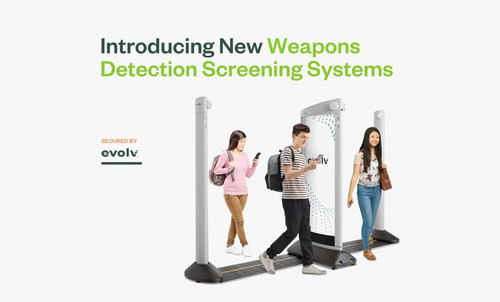Weapon Detection
Evolv Technology at JCPS
Safety is our number one priority and we are always looking for ways to enhance our building security. The Jefferson County Board of Education voted to install weapon detection systems in every JCPS middle and high school and the district is now beginning the process.
This page will provide you with information on the systems and what you can expect.
JCPS Implementation Timeline
Fall 2023 - Installation of devices begins in first half of high schools (First Semester)
Spring 2024 - Installation of devices in remaining high schools (Second Semester)
Fall 2024 - Installation of devices in all middle schools
*Note: Multilevel schools will be done in full when the high school is installed
First Semester
Academy@Shawnee
Ballard
Butler
Doss
duPont Manual
Eastern
Fern Creek
Iroquois
Marion C. Moore
Pleasure Ridge Park
Seneca
Valley
Waggener
Western
Second Semester
Atherton
Brown
Central
Fairdale
Grace James Academy
Jeffersontown
Liberty
Louisville Male
Newcomer
Pathfinder
Phoenix
Southern
TAPP
W.E.B. Dubois
Health and Safety

Scan the QR code for Health & Safety information.
Frequently Asked Questions
Who is Evolv and what is the Evolv Express system?
Evolv Technology (NASDAQ: EVLV) is a leader in AI-based weapons detection security screening. More than 425 million people have been scanned by Evolv technology. The Evolv Express system combines advanced sensor technology with AI technology to deliver frictionless security screening for sports fans, theme park visitors, concertgoers, theatergoers, shoppers, students, teachers, and others.
Is Evolv Technology used in other schools?
More than 350 schools use Evolv Express systems.
Has the Evolv Express been reviewed by federal government agencies responsible for vetting security technologies?
The U.S. Department of Homeland Security awarded the Evolv Express with a SAFETY Act Designation in March 2022.
How many people will an Evolv Express system scan?
A dual-lane system will scan up to 4,000 people per hour, whereas a single-lane system will scan up to 2,000 people per hour.
How does the Express system detect weapons?
The combination of advanced sensors and AI technology enables the Express system to distinguish between everyday items students may bring to school each day and weapons while screening 10x faster than traditional metal detectors.
What makes the Express system different from a traditional metal detector?
Traditional security screening was not designed for today’s dynamic threats and environments, resulting in lengthy queues of students waiting for security screening and frequent secondary screening checks. Evolv technology uses advanced sensors, comprehensive venue analytics, and AI technology to eliminate lines while reducing false alarms.
How does the Express system make it easier and faster for security operators to vet each security alarm?
A red box pinpointing the location of the potential weapon appears on the Flow Control tablet as well as the Alarm Resolution tablet. Security staff can focus on that area of the person’s body or bag rather than asking them to empty all their pockets and bags when using a traditional metal detector.
How does Evolv Flow Control work?
Students, teachers, administrators, and visitors who approach the Express systems simply walk through the system. If status indicators for the Flow Control staff members remain green, the person continues walking to their destination. If the status indicators for the Flow Control staff members turn red, the Flow Control tablets held by security staff emit a beep and the area of a person’s body or bag, where the threat was detected, is highlighted with a red box. Flow Control security staff then directs the person to the Alarm Resolution table for a secondary check.
How does Evolv Alarm Resolution work?
Security staff at the Alarm Resolution tables focus on only the location of the threat. The security staff member identifies the threat type by selecting and tapping an icon representing the nature of the threat (e.g., gun, umbrella, stroller, etc.).
Can the Express system be moved and used indoors and outdoors?
Yes, Express systems have wheels and can be moved and stored. They also can be used indoors and outdoors and a special ruggedized design makes it easy to move them over non-finished and sloped surfaces in outdoor environments for screening at football games and other outdoor events.
What is the process for dealing with Chromebooks and other devices that may set off false threat alarms?
There are multiple methods that schools can employ to minimize the number of alarms set off by Chromebooks and laptops - placing Chromebooks on a conveyor that goes around the express system tower, passing Chromebooks to security operators who hand them back to students after they pass through scanning. Alternatively, Chromebooks can be placed on a table next to the system’s external tower with students picking them up on the other side of the tower after passing through the Evolv Express scanning lane.
Does the Express system accommodate students, staff, and visitors with mobility issues?
Each lane on the Express is 39.8 inches wide, which fits standard-sized wheelchairs, walkers, scooters, and other assistance devices. The mat between the towers measures .89 inches in height, and is sloped, minimizing issues with wheels, crutches, and walkers.
What if there is a medical emergency at the school? Can paramedics enter through an Express system without any difficulty or obstruction?
In the event of an emergency at a school, paramedics and other emergency personnel will be able to pass through the Express system. Each lane on the Express is 39.8 inches wide, which easily accommodates standard-sized wheelchairs and gurneys. Further, the mat measures .89 inches in height and is sloped, making it accessible to standard gurneys and wheelchairs.
What screening processes exist for students and others with a disability or a medical device or any with concerns about going through the Evolv system?
In keeping with FDA guidance on EAS and walk-through metal detectors, it is recommended that visitors and system operators with implantable or wearable medical devices consult their device manufacturer or physician for information relating to their specific device. An alternative screening approach is available at all schools.



